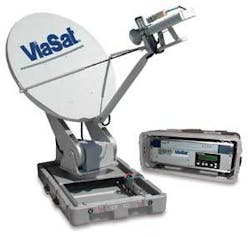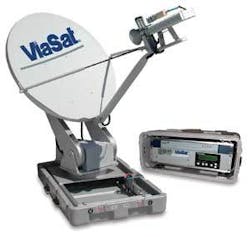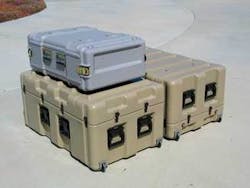ViaSat’s LinkStar system delivers satellite links easily, quickly
It’s as if satellite communications were made “to order” for the oil and gas industry. The more remote the location at sea, the more a satellite beam makes sense to offshore operators. Across oceans or over rugged terrain, connections can be implemented quickly and provide broadband IP data as though the user were connected via hard wire or fiber optics.
Fortunately, today’s satellite communications have matured to the point that they have become relatively easy to set up and use, and they match all the features and applications of terrestrial communications. For offshore E&P operations and subsea pipeline monitoring and control, the choice of satellite communications over other modes is an intelligent alternative.
ViaSat, headquartered in Carlsbad, Calif., near San Diego, has packaged its LinkStar satellite communication system into a “flyaway” package contained in three rugged transport cases that can be easily moved to any offshore location.
Quick setup for fast satellite access
The LinkStar flyaway system features easy installation and commissioning features. Non-satellite technicians can move terminals into place and be set up and running in 20 to 30 minutes, with a self-pointing antenna that automatically finds the right satellite carrier. The system features high-speed data rates in both inbound and outbound directions and an advanced virtual networking feature that enables many customers to securely share a single hub installation.
Applications in the oil and gas industry require a different data traffic pattern than most satellite communications links. A high-speed return channel is very important in these networks, where most data flow from remote sites to the hub, reversing the typical hub-spoke traffic pattern. The LinkStar system is one of the few star-architecture VSAT (Very Small Aperture Terminal) systems that can send data from remote sites back to the hub at very high rates, with a maximum of more than 3 mb/sec.
Finally, a key LinkStar VSAT differentiator is its VLAN Tagging feature. LinkStar modems include the latest advances in multi-protocol label switching (MPLS) technology to provide secure segregation and correct routing of customer data traffic within a single satellite communication system. The VLAN Tagging capability enables network operators to provide many different customers with their own virtual private networks (VPNs) from a single hub installation. These “multi-tenant” VPNs are completely secure from other shared-hub customers and automatically authorize users as they log in and request access to network resources. Each of the customers can receive their own custom level of privacy and service.
Terminals fixed for monitoring, control
Satellite communications is well suited to monitoring offshore production or pipeline operations. While some VSAT systems are optimized only for broadband data rates, the LinkStar system is equally efficient for low-rate applications such as Supervisory Control and Data Acquisition (SCADA). LinkStar VSATs provide extremely efficient bits-per-hertz bandwidth usage, as well as a host of bandwidth management possibilities that suit such applications ideally.
ViaSat has implemented such a system in the People’s Republic of China that monitors about 300 locations along a gas pipeline. Each SCADA station includes Remote Terminal Units (RTUs) that measure parameters such as flow rate, flow pressure, and temperature. The RTUs report the measured parameters to the central SCADA servers, which analyze the data, and send out control messages to the stations, as well as corrective measures, if required.
Most SCADA RTU stations in remote areas are unmanned, so they require automated monitoring and control from the SCADA servers, which requires highly reliable communication links. The network in China typically carries the following applications on the LinkStar network:
- SCADA: SCADA data from RTUs is sent out to the SCADA processing servers at the central site, based on poll requests coming from the central servers. These RTUs are typically provided with 2.4-kb/sec bandwidth, which is available to them on demand. From a common pool of bandwidth, the RTUs are dynamically allocated this chunk of bandwidth by using the LinkStar multi-frame bandwidth-on-demand (BOD) feature
- Specific SCADA: Some specific SCADA data from regional centers need to go to the central SCADA servers at up to 64 kb/sec. Considering how critical this data exchange is, the LinkStar VSAT at these RTUs uses a Committed Information Rate (CIR) mode to allocate a fixed 64 kb/sec bandwidth for each link
- Telephony: Voice from specific RTU stations is carried over the network as Voice-over IP to the central servers. These RTU Stations use Cisco VoIP equipment, and bandwidth is made available using dynamic BOD on the LinkStar NMS, along with network VOIP compression features, to enable very efficient bandwidth usage for voice networking
- Video: Some of the RTUs need to send video images of the meters to the central site. Since these images are not fast moving, the China pipeline uses closed-circuit video equipment for low-frame video transmission. On the LinkStar VSAT, up to 64 kb/sec bandwidth is allocated to this application on a CIR re-allocation basis, so other locations can use the bandwidth when the video application is off.
Satellite link key to efficient offshore communications
With IP becoming ade facto standard for communications, and the stringent uptime and availability requirements for any network in the oil and gas industry, satellite communications provides the best connections based on several key parameters, among which are:
- A geographically diverse spread of locations
- Quick deployment
- High link reliability and availability
- High bandwidth efficiency, which means low operating costs
- An integrated, single private network for easy monitoring and control.
A leading manufacturer of commercial VSAT software and hardware products and a successful producer of broadband communication integrated circuits and satellite communication systems, ViaSat was founded in 1986 by three people with an initial capital investment of less than $25,000. Today, the company is publicly owned, and employs more than 1,200 highly skilled professionals. The company has been honored for its superior growth and performance by INC, Forbes, Fortune, BusinessWeek, Business 2.0, and Red Herring.
For more information about the LinkStar system or other ViaSat products or services, contact them at 760-476-2200 (phone) or 760-929-3941 (fax). Website:www.viasat.com.


